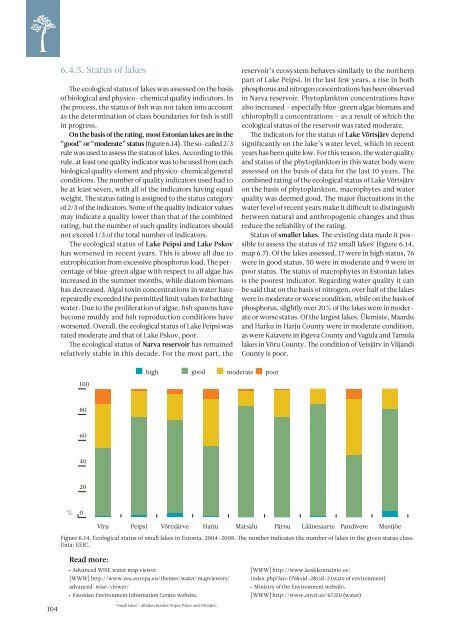ESTONIAN ENVIRONMENTAL REVIEW 2009
ESTONIAN ENVIRONMENTAL REVIEW 2009
ESTONIAN ENVIRONMENTAL REVIEW 2009
Create successful ePaper yourself
Turn your PDF publications into a flip-book with our unique Google optimized e-Paper software.
6.4.5. Status of lakes<br />
The ecological status of lakes was assessed on the basis<br />
of biological and physico- chemical quality indicators. In<br />
the process, the status of fish was not taken into account<br />
as the determination of class boundaries for fish is still<br />
in progress.<br />
On the basis of the rating, most Estonian lakes are in the<br />
“good” or “moderate” status (figure 6.14). The so-called 2/3<br />
rule was used to assess the status of lakes. According to this<br />
rule, at least one quality indicator was to be used from each<br />
biological quality element and physico-chemical general<br />
conditions. The number of quality indicators used had to<br />
be at least seven, with all of the indicators having equal<br />
weight. The status rating is assigned to the status category<br />
of 2/3 of the indicators. Some of the quality indicator values<br />
may indicate a quality lower than that of the combined<br />
rating, but the number of such quality indicators should<br />
not exceed 1/3 of the total number of indicators.<br />
The ecological status of Lake Peipsi and Lake Pskov<br />
has worsened in recent years. This is above all due to<br />
eutrophication from excessive phosphorus load. The percentage<br />
of blue-green algae with respect to all algae has<br />
increased in the summer months, while diatom biomass<br />
has decreased. Algal toxin concentrations in water have<br />
repeatedly exceeded the permitted limit values for bathing<br />
water. Due to the proliferation of algae, fish spawns have<br />
become muddy and fish reproduction conditions have<br />
worsened. Overall, the ecological status of Lake Peipsi was<br />
rated moderate and that of Lake Pskov, poor.<br />
The ecological status of Narva reservoir has remained<br />
relatively stable in this decade. For the most part, the<br />
reservoir’s ecosystem behaves similarly to the northern<br />
part of Lake Peipsi. In the last few years, a rise in both<br />
phosphorus and nitrogen concentrations has been observed<br />
in Narva reservoir. Phytoplankton concentrations have<br />
also increased – especially blue-green algae biomass and<br />
chlorophyll a concentrations – as a result of which the<br />
ecological status of the reservoir was rated moderate.<br />
The indicators for the status of Lake Võrtsjärv depend<br />
significantly on the lake’s water level, which in recent<br />
years has been quite low. For this reason, the water quality<br />
and status of the phytoplankton in this water body were<br />
assessed on the basis of data for the last 10 years. The<br />
combined rating of the ecological status of Lake Võrtsjärv<br />
on the basis of phytoplankton, macrophytes and water<br />
quality was deemed good. The major fluctuations in the<br />
water level of recent years make it difficult to distinguish<br />
between natural and anthropogenic changes and thus<br />
reduce the reliability of the rating.<br />
Status of smaller lakes. The existing data made it possible<br />
to assess the status of 152 small lakes J (figure 6.14,<br />
map 6.7). Of the lakes assessed, 17 were in high status, 76<br />
were in good status, 50 were in moderate and 9 were in<br />
poor status. The status of macrophytes in Estonian lakes<br />
is the poorest indicator. Regarding water quality it can<br />
be said that on the basis of nitrogen, over half of the lakes<br />
were in moderate or worse condition, while on the basis of<br />
phosphorus, slightly over 20% of the lakes were in moderate<br />
or worse status. Of the largest lakes, Ülemiste, Maardu<br />
and Harku in Harju County were in moderate condition,<br />
as were Kaiavere in Jõgeva County and Vagula and Tamula<br />
lakes in Võru County. The condition of Veisjärv in Viljandi<br />
County is poor.<br />
high<br />
good<br />
moderate<br />
poor<br />
100<br />
80<br />
60<br />
40<br />
20<br />
%<br />
0<br />
Viru<br />
Peipsi<br />
Võrtsjärve<br />
Harju<br />
Matsalu<br />
Pärnu<br />
Läänesaarte<br />
Pandivere<br />
Mustjõe<br />
Figure 6.14. Ecological status of small lakes in Estonia, 2004–2008. The number indicates the number of lakes in the given status class.<br />
Data: EEIC.<br />
Read more:<br />
• Advanced WISE water map viewer.<br />
[WWW] http://www.eea.europa.eu/themes/water/mapviewers/<br />
advanced-wise-viewer/<br />
• Estonian Environment Information Centre website.<br />
[WWW] http://www.keskkonnainfo.ee/<br />
index.php?lan=EN&sid=2&tid=2 (state of environment)<br />
• Ministry of the Environment website.<br />
[WWW] http://www.envir.ee/67250 (water)<br />
104<br />
J<br />
Small lakes – all lakes besides Peipsi, Pskov and Võrtsjärv.

















